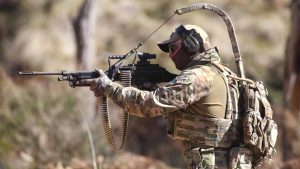The National Interest:
The U.S. Army’s standard infantry weapon repeatedly overheated and jammed during a bloody 2008 battle in Afghanistan. The Washington Times reported last week on the reported failure of the M-4 carbine during the fierce firefight in Wanat, during which the Taliban nearly overran an Army outpost.
A direct descendant of the Vietnam War-era M-16, the more compact M-4 is the Army’s standard-issue weapon. The ground combat branch has half a million of the semi-automatic weapons in service and has signed contracts for 120,000 more.
The Army and manufacturers are improving the M-4 to reflect battlefield lessons, but it’s unclear whether these upgrades will prevent another near-catastrophe like occurred at Wanat.
In the early morning hours of July 13, 2008, a Taliban force of between 100 and 200 fighters attacked an American Forward Operating Base guarded by 48 soldiers of 2nd Platoon, Chosen Company—part of 2nd Battalion, 503rd Infantry Regiment.
The paratroopers had just arrived in the area five days prior. The Taliban had been watching—and attacked before the platoon could finish setting up its defenses, which typically include walls, razor wire and machine guns.
Firing machine guns, rocket-propelled grenades and mortars, the Taliban swarmed the American position. The U.S. soldiers called in Apache attack helicopters, 155-militmeter howitzers and even a B-1 heavy bomber to pound the attackers.
The Americans held their ground. But nine soldiers died and 27 suffered wounds. Around 50 Taliban died and evidence suggests 40 were wounded.
In stand-up fights like Wanat, whichever side is able to generate fire superiority—in other words, throw out more lead—has the advantage. This is particularly important for the defenders, as sheer firepower can slow the attackers’ advance until help arrives.
The paratroopers had brought to the outpost two heavy machine guns, two automatic grenade launchers and an anti-tank missile. These were supposed to be the linchpins of Wanat’s defenses, but accurate Taliban fire disabled most of these heavier weapons early in the battle.
Fire superiority fell to the M-4s. In the Army’s report on Wanat, one soldier described alternating between three M-4s, using each until it jammed.
“My weapon was overheating,” another soldier said. “I had shot about 12 magazines by this point already and it had only been about half an hour or so into the fight.” In other words, the soldier fired approximately 360 rounds in 30 minutes. That’s 14 rounds a minute—one every four seconds.
This one was originally published by War is Boring. In my experience The National Interest produces click bait and nothing more. Most of their articles are un-serious. When they publish someone else in entirety it’s usually better, but in this case I cannot believe they are publishing this claptrap this late in the game. There are so many errors in this commentary it’s hard to believe they went ahead with it.
To begin with, the Taliban force was near Battalion size, not 100 to 200 fighters. They fielded nearly 600 fighters. The Taliban weren’t just watching them as they set up the COP, they knew a full one year in advance what was going to happen and where it was going to be based on the felt-need of the Army to get “permission” from tribal elders. Contrast this with the USMC in the Helmand Province where they would go in and set up a COP overnight with no permission from anyone.
This wasn’t a “stand-up” fight. No one was standing (at least, not U.S. forces unless behind barriers). The majority of the heavy losses were suffered at Observation Post Topside, which was poorly positioned and improperly manned. The US force size was too small. It was in a valley. They had no CAS, the ring-knockers from Joyce let them down while they sipped coffee or played video games.
Blaming it on the M-4 is the stupidest thing they could have done, and articles written that way are looking to place blame somewhere other than squarely on the shoulders of flag and staff officers. Finally, how many videos of run-to-failure full automatic fire with AR-15s do we have to show you to convince you that no one needs a piston AR, and that the direct impingement Eugene Stoner design does just fine. How can we post videos of ARs shooting full auto for 800 rounds before the barrel melts without a single FFT / FTE before they stop blaming the rifle and start blaming upper command for the failure at Wanat?
By the way, I’m still proud to have three URLs associated with the Army report on Wanat. PDF warning. Page 255.
Prior: Battle of Wanat (category)





